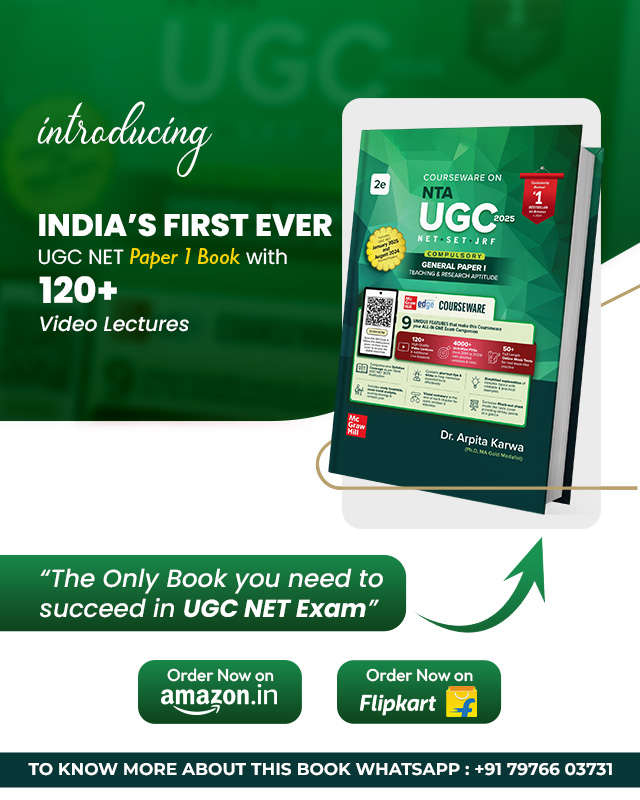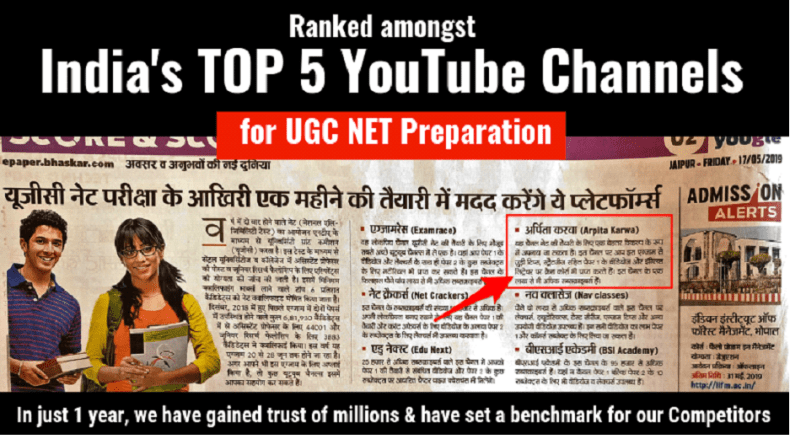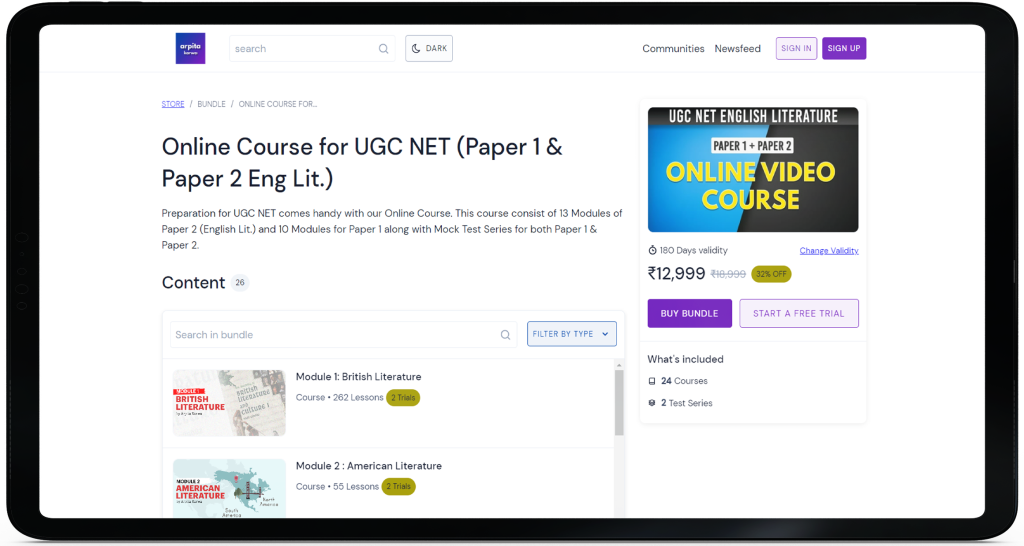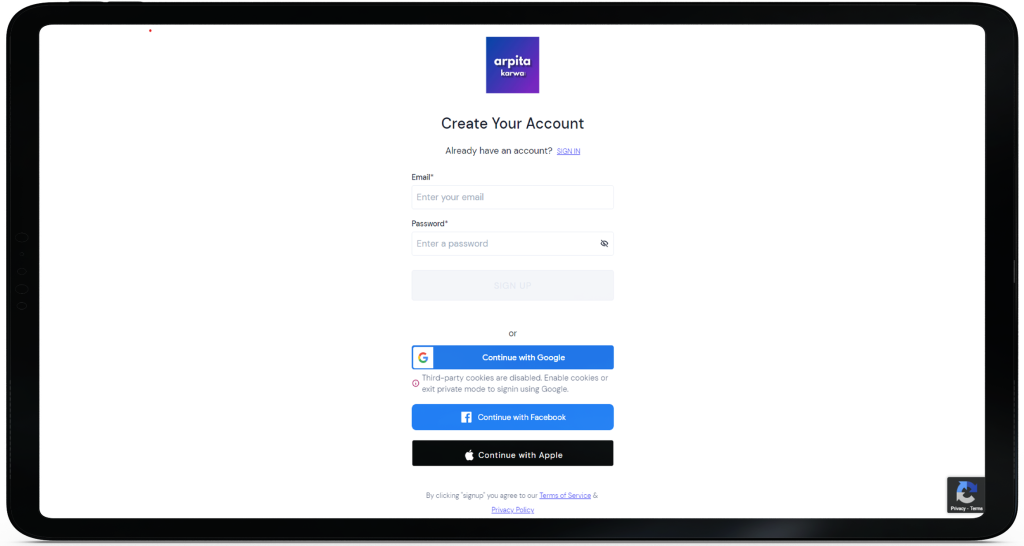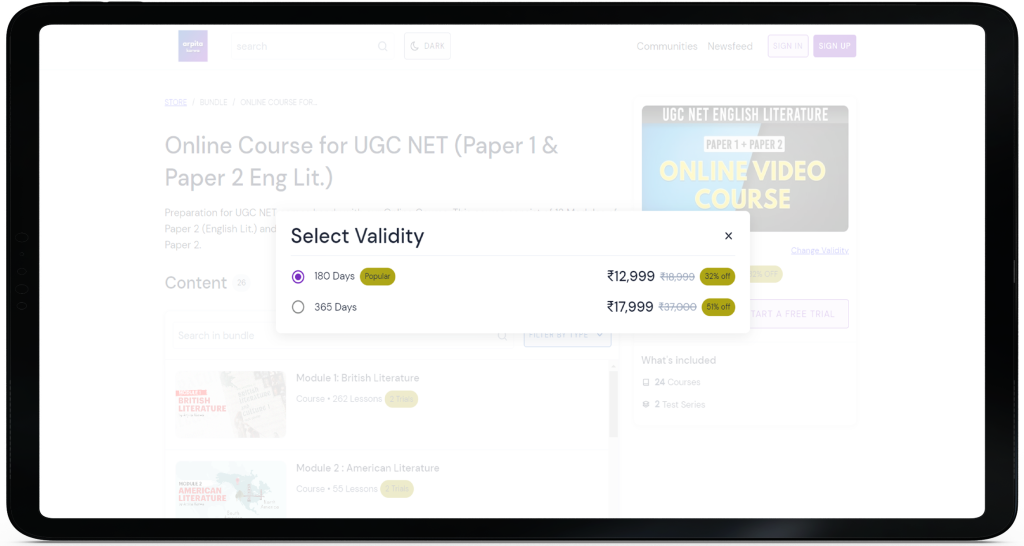UNIVERSITY OF DELHI M.A. ENGLISH, ENTRANCE EXAM 2020
June 19, 2023 2023-12-11 18:34UNIVERSITY OF DELHI M.A. ENGLISH, ENTRANCE EXAM 2020
University of Delhi M.A. English, Entrance Exam 2020
UNIVERSITY OF DELHI
M.A. ENGLISH, ENTRANCE EXAM 2020
Q.1) Name the only dramatist who was awarded both the Nobel Prize and the Oscar?
[1] George Bernard Shaw
[2] Arthur Miller
[3] Tennessee Williams
[4] None of these
Q.2) The statement “character is destiny” is predominantly associated with
(a) Heraclitus
(b) Shakespearean tragedy
(c) Aeschylus
Choose the correct answer from the options given below:
[1] (a) only
[2] (b) only
[3] (c) only
[4] Both (a) and (b)
Q.3) Pick the odd one out among the following:
[1] Malgudi
[2] Yoknapatawpha County
[3] Barsetshire
[4] Middlemarch
Q.4) Identify the correct statement(s):
(a) A Doll’s House is a play by Henrik Ibsen.
(b) The Doll’s House’ is a short story by Katherine Mansfiel [4]
Choose the correct answer from the options given below:
[1] (a) only
[2] (b) only
[3] (a) and (b) only
[4] None of these
Q.5) Which of these is a type of content word?
(a) Nouns
(b) Demonstrative Pronouns
(c) Interrogative pronouns
(d) Prepositions
Choose the correct answer from the options given below:
[1] (c) only
[2] (a) only
[3] (b) and (c) only
[4] (a) and (d) only
Q.6) The tragic hero is not depraved or vicious, but he is also not perfect, and his misfortune is brought upon him by his own………. .
[1] Peripeteia
[2] Anagnorisis
[3] Hamartia
[4] Catharsis
Q.7) ………. was initially a literary and philosophical movement, it is a school of thought premised on the idea of language as an opaque medium that does not connect an actor with an “outside” truth but to a structure with parts whose meaning is culled from the parts’ contrasts with each other
[1] Dialogism
[2] Psychoanalysis
[3] Post-structuralism
[4] Formalism
Q.8) “Will all great Neptune’s ocean wash this blood Clean from my hand? No. This my hand will rather The multitudinous seas incarnadine, Making the green one red. The above lines are an example of:
[1] Oxymoron
[2] Alliteration
[3] Synecdoche
[4] Hyperbole
Q.9) Arrange the following sentences in the proper mo order and choose the correct answer from the given options.
The uniqueness of:
(a) also, the changes it may have suffered
(b) in physical conditions over the years
(c) the work of art includes
(d) the changes in its ownership
Choose the correct answer from the options given below:
[1] (a), (b), (d) and (c)
[2] (c), (d), (a) and (b)
[3] (a), (b), (c) and (d)
[4] (b), (a), (c) and (d)
Q.10) Which of the following statements is incorrect in context to Magical Realism?
[1] Magic realism is chiefly a North-American narrative strategy that is characterized by the matter-of-fact inclusion of fantastic or mythical elements into seemingly realistic fiction.
[2] It is a natural outcome of postcolonial writing, which must make sense of at least two separate realities-the reality of the conquerors as well as that of the conquered.
[3] There is a distortion effect in the very fibre of the prose that forces the reader to question what is real and often opens up avenues of reality we may not have thought possible before reading the story.
[4] Prominent among the magic realists are Gabriel Garcia Marquez, Jorge Amado, Jorge Luis Borges, Julio Cortazar, and Isabel Allende.
Q.11) Arrange the following sentences in the proper order and choose the correct answer from the codes given below:
(a) I secretly hoped he’d spend the rest of his life with us and planned to do my best to persuade him.
(b) All except Hanuman, to whom we were greatly attached – Ram, Lakshman and I, each having our reasons for he’d saved us all in different ways.
(c) We requested him to accompany us to Ayodhya and be with us for Ram’s long deferred coronation.
(d) Over the next three days, Ram and I gave many gifts to the monkey soldiers – jewels and armour and rare fruits from Ravan’s gardens – and sent them off to their homes.
Choose the correct answer from the options given below:
[1] (d), (b), (c) and (a)
[2] (a), (b), (c) and (d)
[3] (b), (c), (d) and (a)
[4] (c), (d), (a) and (b)
Q.12) Identify the kind of narrator reflected through the following excerpt “At six minutes past midnight, Tuesday morning, on the way home from a late rehearsal of her new stage show, Tina Evans saw her son, Danny, in a stranger’s car. But Danny had been dead more than a year.”
[1] First person narrator
[2] Second person narrator
[3] Third person narrator
[4] Fallible narrator
Q.13) Arrange the sentences P, Q, R, S in the order they should come in between S1 and S6.
S1: While still a child Narendra practised meditation with a friend before the image of Siva.
S2: _____________________
S3: _____________________
S4: _____________________
S5: _____________________
S6: The apparition was about to say something when Naren became frightened and left the
room. He thought later that perhaps this had been a vision of Buddha
P: On one occasion he saw in a vision a luminous person of serene countenance who was carrying the staff and waterbowl of a monk.
Q: He had heard that the holy men of ancient India would become so absorbed in contemplation of God that their hair would grow and gradually enter into the earth, like the roots of the banyan tree.
R: While meditating, therefore, he would open his eyes, now and then, to see if his own hair had entered into the earth.
S: Even so, during meditation, he often became unconscious of the world.
[1] PQRS
[2] QRSP
[3] RSPQ
[4] SPQR
Q.14) Which of the following assertions are correct?
(a) Lines of iambic pentameter rhyming in pairs form heroic couplet.
(b) Rhythmic pattern in a free verse is not organized into a regular metrical form
(c) Haiku is an Italian poetic form of sixteen syllables arranged into three lines of five, six and five syllables.
(d) In Pindar’s Ode the chorus chants strophe while moving in a dance rhythm to the right Choose the correct answer from the options given below:
[1] (a) and (b)
[2] (c) and (d)
[3] (b) and (c)
[4] (d) and (a)
Q.15) A………………. is a five-line poem that consists of a single stanza, an AABBA rhyme scheme, and whose subject is a short, pithy tale or description.
[1] Villanelle
[2] Haiku
[3] Limerick
[4] Ode
Q.16) A foot composed of two successive syllables with approximately equal light stresses is……….
[1] Trochaic
[2] Pyrrhic
[3] Spondaic
[4] Dactylic
Q.17) The term “dissociation of sensibility” to describe the aesthetic frame of mind was first used by:
[1] T.S. Eliot
[2] Joseph Addison
[3] Henry Home
[4] Lord Kames
Q.18) Which of the following plays use Chorus as a dramatic feature?
Choose from the given codes
(a) Doctor Faustus by Christopher Marlowe
(b) The White Devil by John Webster.
(c) The Tempest by William Shakespeare
(d) Murder in the Cathedral by T.S. Eliot
Choose the correct answer from the options given below:
[1] (a) and (b)
[2] (b) and (c)
[3] (c) and (d)
[4] (a) and (d)
Q.19) Match the lines in List-I with the poems in which these occur in List-II and choose the correct answer from the given codes:
List-I
(a) Our birth is but a sleep and a forgetting. The Soul that rises with us, our life’s Star
(b) Wild Spirit, which art moving everywhere; and preserver; hear, oh hear!
(c) Where Beauty cannot keep her lustrous eyes, Or new Love pine at them beyond tomorrow.
(d) Where dost thou careless lie, Buried in ease and sloth?
List-II
(i) Ode to the West Wind
(ii) Ode: Intimations of Immortality
(iii) Ode to Nightingale
(iv) An Ode to Himself
Codes:
[1] a-i, b-iv, c-iii, d-ii
[2] a-ii, b-i, c-iii, d-iv
[3] a-iii, b-i, c-ii, d-iv
[4] a-iv, b-i, c-iii, d-ii
Q.20) Identify the key features of a Brechtian Theatre and choose the correct answer from the given codes:
(a) Montage
(b) Explanatory caption
(c) Anti-illusive technique
(d) Catharsis
(e) Compact plot
Codes:
[1] (a), (b) and (c)
[2] (b), (c) and (d)
[3] (c), (d) and (e)
[4] (b) and (d)
Q.21) Geniuses of countless nations Have told their love for generations Till all their memorable phrases Are common as goldenrod or daisies.
The above lines are written in
[1] Tetrasyllabic Couplet
[2] Decasyllabic Couplet
[3] Pentasyllabic Couplet
[4] Octosyllabic Couplet
Q.22) Match the literary works in List-I with their authors in List-II and choose the correct. Answer from the given codes:
List-I
(a) Pale Fire
(b) The Sound and the Fury
(c) Rosencrantz and Guildenstern are Dead
(d) Under the Greenwood Tree
(e) Of Cakes and Ale
List-II
(i) Thomas Hardy
(ii) Somerset Maugham
(iii) William Faulkner
(iv) Tom Stoppard
(v) Vladimir Nabokov
Codes:
[1] a-v, b-iv, c-iii, d-i, e-ii
[2] a-iv, b-v, c-ii, d-iii, e-i
[3] a-v, b-iii, c-iv, d-i, e-ii
[4] a-iii, b-iv, c-ii, d-v, e-i
Q.23) ……… was written to be recited rather than acted; but to English playwrights, who thought these tragedies had been intended for the stage, they provided the model for an organized five-act play with a complex plot and elaborately formal style of dialogue.
[1] Revenge Tragedy
[2] Senecan Tragedy
[3] Tragicomedy
[4] Domestic Tragedy
Q.24) Anthropomorphism is:
[1] The shaping of something in material form or terms
[2] The attribution of human characteristics to non-human creatures and beings
[3] A way of expressing the grief on the occasion of the death of a person
[4] Both A & B
Q.25) Which among the following statements is not true about New Critics?
[1] Their function is to analyse, interpret and evaluate a work of art
[2] They are anti-impressionistic
[3] They opposed both to historical and comparative method of criticism
[4] Their approach is dogmatic and narrow
Q.26) Lolita was ranked fourth in the list of the Modern Library 100 Best Novels in 2007. The writer of the novel is:
[1] Alexander Pushkin
[2] Vladimir Nabokov
[3] Mikhail Bulgakov
[4] Nikolai Gogoi
Q.27) Which of the following plays of Shakespeare does not contain any Shakespearean sonnet?
[1] Romeo and Juliet
[2] Henry V
[3] Love’s Labour Lost
[4] Troilus and Cressida
Q.28) Which of the following statements are correct in context to Surrealism?
Choose from the codes given below?
(a) It was originally a French movement.
(b) It was influenced by Surrealist painting, that uses surprising images and transitions to play off of formal expectations and depict the unconscious rather than conscious mind.
(c) The term “Surrealism” is said to have been coined by Guillaume Apollinaire as early as 1917.
(d) Surrealists expressed their rejection of capitalism in artistic expression that appeared to reject logic and embrace chaos and irrationality.
Codes:
[1] (a) and (d)
[2] (a), (c) and (d)
[3] (b) and (d)
[4] (a), (b) and (c)
Q.29) ………… had an influence on innovative literary, artistic, and intellectual developments in the two decades after the First World War. The members of this group opposed the narrow post-Victorian restrictions in both the arts and morality.
[1] Lake Poets
[2] Bloomsbury Group
[3] Cavalier Poets
[4] Metaphysical Poets
Q.30) Saadat Hasan Manto was charged for obscenity for writing:
[1] Thanda Gosht
[2] Angarey
[3] Lihaaf
[4] Both A & C
Q.31) “O death in life, the days that are no more.” Identify the figure of speech used in this extract.
[1] Simile
[2] Oxymoron
[3] Antithesis
[4] Paradox
Q.32) Which of the following statements is true about Chicago School?
[1] It was a reaction to New Criticism
[2] It valued the structure or form of literary work as a whole
[3] It was interested in plot and design of literary work as a whole
[4] All of these
Q.33) Which feminist writer created Judith Shakespeare, the imaginary sister of William Shakespeare, to advance her arguments of gender inequality?
[1] Judith Butler
[2] Stephen Greenbelt
[3] Virginia Woolf
[4] Simone de Beauvoir
Q.34) Chaucer’s General Prologue to The Canter-bury Tales is written in form of a/an……………..
[1] Epic Satire
[2] Medieval Estate Satireold
[3] Romantic Comedy
[4] Medieval Romance
Q.35) ………. is the author of Persepolis, a coming-of-age visual memoir documenting childhood of a little girl growing up in Iran during the Islamic Revolution.
[1] Marjane Satrapi
[2] Azar Nafisi
[3] Fatima Mernissi
[4] Saba Mehmood
Q.36) Which of the following texts deals with the life of Anjum, a Hijra from the old Delhi?
[1] Me Laxmi, Me Hijra by Laxmi
[2] The Truth About Me: A Hijra Life Story by A. Revathi
[3] The Ministry of Utmost Happiness by Arundhati Roy
[4] Delhi by Khushwant Singh
Directions (Qs. Nos. 37-39): Read the following and answer the questions.
Q.37) Remember me when I am gone away, Gone far away into the silent land; When you can no longer hold me by the hand, Nor I half turn to go yet turning stay. Remember me when no more day by day You tell me of our future that you plann’d: Only remember me; you Understand It will be late to counsel then or pray. Yet if you should forget me for a while And afterwards remember, do not grieve: For if the darkness and corruption leave A vestige of the thoughts that once I had, Better by far you should forget and smile Than that you should remember and be sad.Which kind of rhetoric does the above lines represent?
[1] Satire
[2] Sonnet
[3] Villanelle
[4] Dirge
Q.38) And now too soon for us the circling hours This dreaded time has compast, wherein we Must bide the stroke of that long threat’n’d wound Which kind of rhetoric does the above lines represent?
[1] Logos
[2] Pathos
[3] Kairos
[4] Ethos
Q.39) Dawn in New York has four pillars of muck and a hurricane of black pigeons splashing in the putrid waters.
Dawn in New York moans on the immense staircases searching between the corners for spikenards of depicted anguish
Which literary movement does the above ion lines depict?
[1] Surrealism
[2] Imagism
[3] Vorticism
[4] Futurism
Q.40) When………….’s plays are sequenced in time, they also reveal that his outlook might have changed, providing a “spiritual biography” along these lines:
An early period of high tragedy (Medea, Hippolytus) followed by a patriotic period at the outset
of the Peloponnesian War (Children of Heracles, The Suppliants). Thereafter, a middle period of
disillusionment at the senselessness of war (Hecuba, The Trojan Women). We then discover an
escapist period with a focus on romantic intrigue (Ion, Iphigenia in Tauris, Helen) and a final
period of tragic despair (Orestes, Phoenician Women, The Bacchae).
Who is being talking about in the above lines
[1] Ariosto
[2] Euripides
[3] Aeschylus
[4] Racine
Q.41) Which of the following is an example of Dystopia?
[1] The Castle of Otranto
[2] News from Nowhere
[3] The Handmaid’s Tale
[4] Murder in the Cathedral
Q.42) Who among the following is a theorist of memory, history and forgetting?
[1] Alan Tate
[2] Antonio Gramsci
[3] Arjun Appadurai
[4] Paul Ricoeur
Q.43) Antonin Artaud’s plays deal in:
[1] Cruelty
[2] Nominalism
[3] Vendetta
[4] Stoicism
Q.44) The author of No Full Stops in India is:
[1] Asad Zaidi
[2] William Dalrymple
[3] Mark Tully
[4] Thomas Babington Macaulayi
Q.45) Gone Girl by Gillian Flynn is an example of:
[1] Portmanteau novel
[2] Crime Thriller
[3] Gothic Fiction
[4] Science Fiction
Q.46) Read the passage and answer the question.
The question whether objective truth can be attributed to human thinking is not a question of theory but is a practical question. Man must prove the truth.i.e. the reality and power, the this-sidedness of his thinking in practice. The dispute over the reality or non-reality of thinking that is isolated from practice is a purely scholastic question.
Who would you attribute the above lines to?
[1] Walter Benjamin
[2] Emile Zola
[3] Richard Rorty
[4] Karl Marx
Q.47) O Friend! The termination of my course Is nearer now…
Where are thou? Hear I not a voice From thee.
The “Friend” in this line is an allusion to:
[1] Victor Frankenstein
[2] Samuel Taylor Coleridge
[3] Thomas Keats
[4] James Boswell
Q.48) ‘It is not singular that, as a daughter of two persons of distinguished literary celebrity, I should very early in life thought of writing [However]…My dreams were at once more fantastic and agreeable than my writings…] accounted for them to nobody: they were my refuge when annoyed-my dearest pleasure when free.’These prefatory remarks are written by
[1] Charlotte Bronte for Vilette
[2] George Eliot for The Mill on the Floss
[3] Charles Dickens for Great Expectations
[4] Mary Shelley for Frankenstein
Q.49) ‘The grand source of female folly and vice has ever appeared to me to arise from narrowness of mind; and the very constitution of civil governments has put almost insuperable obstacles in the way to prevent the cultivation of female understanding; yet virtue cannot be built on any other foundation.”These lines are from the feminist manifesto
[1] A Room of One’s Own
[2] A Vindication of the Rights of Woman
[3] The Second Sex
[4] The Female Eunuch
Q.50) The Preface to the Lyrical Ballads was published in the year: the year:
[1] 1798
[2] 1800
[3] 1795
[4] 1804
Q.51) What is the subtitle of Wordsworth’s Prelude?
[1] The Modern Prometheus
[2] The Wanderer
[3] Growth of a Poet’s Mind
[4] A Dream,
Q.52) ‘We hate poetry that has a palpable design upon us… Poetry should be great and unobtrusive, a thing which enters into one’s soul, and does not startle it or amaze it with itself but with its subject.’ Which poet wrote this statement?
[1] W.H. Yeats
[2] W.H. Auden
[3] John Keats
[4] Elizabeth Barret Browning
Q.53) Wide Sargasso Sea by Jean Rhys is an anti- colonial response to which famous novel?
[1] Adventures of Huckleberry Finn
[2] Heart of Darkness
[3] The Mill on the Floss
[4] Jane Eyre
Q.54) The Mysteries of Udolpho is written by:
[1] Elizabeth Gaskell
[2] Charles Dickens
[3] Jules Verne
[4] Ann Radcliffe
Q.55) ‘Why did men drink wine and women water? Why was one sex so prosperous and the other so poor? What effect has poverty on fiction?’ The above extract is from a famous work by:
[1] Virginia Woolf
[2] Elaine Showalter
[3] Toril Moi
[4] D.H. Lawrence
Q.56) The author of Orientalism: Western Conceptions of the Orient is:
[1] Homi Bhabha
[2] Edward Said
[3] Salman Rushdie
[4] Gayatri C. Spivak
Q.57) In a Revenge Tragedy ‘Hesitation’ and ‘Procrastination’ suggest:
(a) The moral ambiguity in the act of revenge.
(b) Protagonist’s faith in mitigation.
(c) Libidinal excess in the behaviour of the protagonist.
Choose the correct answer from the options given below:
[1] Only (a)
[2] Only (b)
[3] Only (c)
[4] (b) and (c)
Q.58) Which of the following is correct about Romantic Irony?
[1] It stands for anti-romantic elements in a
[2] It criticises romantic impulses
[3] It sustains the illusion it mockingly shatters
[4] All of these
Q.59) Hamlet is considered as a Christian Tragedy because:
[1] All the characters are Christians
[2] The action is situated in a Christian world
[3] The characters keep on invoking Christ
[4] It depicts an element of Metaphysical Rebellion
Q.60) Which of the following isn’t correct about Confessional poetry?
[1] It deals with mental and physical experiences of the poet’s own life
[2] It was written in rebellion against the demand for impersonality in poetry
[3] It deals with the poet’s religious and spiritual experiences.
[4] It reveals the private and clinical matters about the poet.
Q.61) Which of the following is incorrect about Bhartrihari’s Vakyapadiya?
[1] It is the first treatise written on Sanskrit grammar
[2] It’s a treatise on linguistics
[3] It discusses the philosophy of grammar
[4] It presents the concept of sphota
Q.62) The first novel of Ruskin Bond was The Room on the Roof. The sequel to this novel is:
[1] Our Trees Still Grow in Dehra
[2] Vagrants in the Valley
[3] A Flight of Pigeons
[4] Strangers in the Night
Directions (Qs. Nos. 63-68): Read the poem and answer the question that follow.
The world is not with us enough O taste and see the subway Bible poster said, meaning The Lord, meaning if anything all that lives to the imagination’s tongue, grief, mercy, language, tangerine, weather, to breathe them, bite, savor, chew, swallow, transform into our flesh our deaths, crossing the street, plum, quince. living in the orchard and being hungry, and plucking the fruit. There is an intertextual allusion to another poem.
Q.63) Identify the writer of that poem
[1] Robert Frost
[2] William Wordsworth
[3] William Blake
[4] P. B. Shelley
Q.64) Which among the following lines directly allude to a biblical verse?
[1] Into our flesh our/deaths,
[2] Hungry, and plucking/ the fruit.
[3] O taste and see
[4] If anything all that lives/to the imagination’s tongue
Q.65) What is the predominant mood of the poem?
[1] Reflexive
[2] Authoritative
[3] Pragmatic
[4] Comic
Q.66) Which of the following statement(s) about the poem is/are correct?
(a) Poetry, according to the poem, has nothing to do with escape.
(b) Poetry, according to the poem, has to do with involvement, engagement with the sense
(c) Poetry, according to the poem, should invoke the reader to seize the day.
Choose the correct answer from the options given below:
[1] (a) only
[2] (c) only
[3] all of those
[4] None of these
Q.67) Which among the following line(s) allude to the book of Genesis in the Bible?
(a) into our flesh our/deaths,
(b) hungry, and plucking/the fruit.
(c) O taste and see
(d) living in the orchard
Choose the correct answer from the options given below:
[1] (d) only
[2].(c) only
[3] (a), (b) and (c)
[4] (a), (b) and (d)
Q.68) What is the larger theme that the poem is foregrounding?
[1] The ecstasy of heart
[2] The ecstasy of soul
[3] The ecstasy of mind
[4] The ecstasy of body
Directions (Qs. Nos. 69-72): Question is based on the following extract. Fill in the blanks with the most appropriate option from the choices given below
In Problems of Dostoevsky’s Poetics, ……….(1) ………. developed the concepts which were to inform much of his work. The concept of (2) ………. which is central to this analysis literally means multiple voices. He reads Dostoevsky’s work as containing many different voices, unmerged into a single perspective, and not……… (3) ……… to the voice of the author. Each of these voices has its own perspective, its own validity, and its own ………. (4) ………. weight within the novel.
Q.69) The word in blank (4) is:
[1] Walter Benjamin
[2] Mikhail Bakhtin.
[3] Friedrich Nietzsche
[4] Michel Foucault
Q.70) The word in blank (3) is:
[1] Polyphony
[2] Cacophony
[3] Homophony
[4] Diaphony
Q.71) The word in blank (2) is:
[1] Superordinated
[2] Manipulated
[3] Subordinated
[4] Superior
Q.72) The word in blank (1) is:.
[1] Narrative
[2] Psychological
[3] Calculated
[4] Literal
Directions (Qs. Nos. 73-76): Question is based on the following passage. Read the passage and answer the questions that follow.
Men fear death, as children fear to go in the dark; and as that natural fear in children, is increased with tales, so is the other. Certainly, the contemplation of death, as the wages of sin, and passage to another world, is holy and religious; but the fear of it, as a tribute due unto nature, is weak. Yet in religious meditations, there is sometimes mixture of vanity, and of superstition. You shall read, in some of the friars’ books of mortification, that a man should think with himself, what the pain is, if he have but his finger’s end pressed, or tortured, and thereby imagine, what the pains of death are, when the whole body is corrupted, and dissolved; when many times death passed, with less pain than the torture of a limb; for the most vital parts, are not the quickest of sense. And by him that spake only as a philosopher, and natural man, it was well said, Pompa mortis magisterret, quammorsipsa. Groans, and convulsions, and a discolored face, and friends weeping, and blacks, and obsequies, and the like, show death terrible. It is worthy the observing, that there is no passion in the mind of man, so weak, but it mates, and masters, the fear of death; and therefore, death is no such terrible enemy, when a man hath so many attendants about him, that can win the combat of him.
Q.73) The writing style of the given extract is similar to that of:
[1] Francis Bacon
[2] Charles Lamb
[3] William Hazlitt
[4] Matthew Arnold
Q.74) Identify the tone of the passage:
[1] Pessimistic tone
[2] Conversational tone
[3] Threatening tone
[4] Haughty tone
Q.75) Which one of the following expressions from the given excerpt conveys best the central message of the passage?
[1] “Men fear death, as children fear to go in the dark;”
[2] The “contemplation of death, as the wages of sin, and passage to another world, is holy and religious;”
[3] A “man should think with himself, …..what the pains of death are, when the whole body is corrupted, and dissolved;”
[4] There “is no passion in the mind of man, so weak, but it mates, and masters, the fear of death;”
Q.76) The given passage is an excerpt from:
[1] An objective essay
[2] A subjective essay
[3] A satirical essay
[4] A reflexive essay
Directions (Qs. Nos. 77-80): Question is based on the following passage. Read the passage and answer the following questions.
Orientalism is a style of thought based upon an ontological and epistemological distinction made between “the Orient” and (most of the time) “the Occident.” ….Orientalism can be discussed analyzed as the corporate institution for dealing with the Orient-dealing with it by making statements about it, authorizing views of it, describing it, by teaching it, settling it, restructuring, and having authority over the Orient…. Without examining Orientalism as a discourse, one cannot possibly understand the enormously systematic discipline by which European culture was able to manage – and even produce – the Orient politically, sociologically, militarily, ideologically, scientifically, and imaginatively during the post-Enlightenment period.
Q.77) The passage argues that:
[1] The Orient and the Occident are opposites of each other
[2] European scholars have focused on the socio-political realities of the Orient
[3] European universities do not have enough classes in Eastern culture
[4] Europeans idealise the Orient in attempting to understand it
Q.78) The term “Orientalism” is most closely associated with the theory of:
[1] Structuralism
[2] Deconstruction
[3] New Historicism
[4] Post-colonialism
Q.79) In calling Orientalism a “discourse”, the author draws on the terminology most closely associated with:
[1] Jacques Derrida
[2] Jacques Lacan
[3] Michel Foucault
[4] Gayatri Spivak
Q.80) From the contents of the passage, who among the following appears to be its author?
[1] Stanley Fish
[2] Luce Irigaray
[3] Edward Said
[4] Sara Suleri
Directions (Qs. Nos. 81-83): Question is based on the following passage. Read the passage and answer the following questions.
…………theory, in a nutshell, is where women in the media are viewed from the eyes of a heterosexual man, and that these women are represented as passive objects of male desire. Audiences are forced to view women from the point of view of a heterosexual male, even if they are heterosexual women or homosexual men.
Q.81) Which film theory is being referred to in the above-mentioned extract?
[1] The Male-Male Desire
[2] The Male Gaze
[3] The Romantic Gaze
[4] Auteur Media
Q.82) The theoretical frame work in the above theory was first presented in which of the following texts?
[1] The Second Sex
[2] “Can a Subaltern Speak?”
[3] Visual Pleasure and Narrative Cinema
[4] Imagining Women
Q.83) Who propounded the above-mentioned theory?
[1] Christian Metz
[2] Sigmund Freud
[3] Sara Suleri
[4] Laura Mulvey
Directions (Qs. Nos. 84-88): Question is based on the following poem. Read the poem and answer the following questions.
A low temple keeps its gods in the dark. You lend a matchbox to the priest. One by one the gods come to light. Amused bronze. Smiling stone. Unsurprised. For a moment the length of a matchstick gesture after gesture revives and dies. Stance after lost stance is found and lost again. Who was that, you ask. The eight-arm goddess, the priest replies. A sceptic match coughs. You can count. But she has eighteen, you protest. All the same she is still an eight-arm goddess to the priest. You come out in the sun and light a charminar. Children play on the back of the twenty-foot tortoise.
Q.84) How would you describe the mood of the above poem?
[1] Angry
[2] Reflective
[3] Ironic
[4] Alienated
Q.85) Which of the following binaries is least relevant to the poem?
[1] Reason and Faith
[2] Light and Dark
[3] Gods and Demons
[4] Belief and Disbelief
Q.86) Which of the following statements is most appropriate for the above poem?
[1] Gods depend on humans.
[2] Gods give meaning to human existence.
[3] The eight-armed goddess has the power of eighteen arms.
[4] The poet is mocking the faith of ordinary people.
Q.87) What do the children in the last line stand for?
[1] Vitality
[2] Innocence
[3] Irreverence
[4] Cruelty
Q.88) Which of the following four qualities do you think the poet treasures the most?
[1] Faith
[2] Materialism
[3] Observation
[4] Gullibility
Directions (Qs. Nos. 89-91): Question is based on the following passage. Read the passage and answer the following questions.
The traditional monolithic view of English provides us with, and is buttressed by, a mix of both everyday and technical vocabulary that presents English as a single entity. An example is the quasi-singular uncountable noun English itself, which represents a single mass comparable to bread and wine. Another is how the words dialect and language are used as everyday expressions and in technical terminology,
Q.89) English is compared to bread and wine due to which of the following factors?
[1] Cultural
[2] Grammatical
[3] Political
[4] Literary
Q.90) Which of the following statements can be deduced from the passage?
[1] English is a hegemonic language that perpetuates cultural subjugation.
[2] It would be appropriate to classify English as a language and not as a dialect.
[3] It may be appropriate to think of English in the plural rather than in the singular.
[4] English as a language has many dialects. which may differ from each other to some extent.
Q.91) Which of the following statements is corroborated by the passage?
[1] Everyday expressions should not be mixed with technical vocabulary.
[2] It is impossible to form the grammatical plural form for an uncountable noun.
[3] A language has many dialects just as there are many varieties of bread and wine.
[4] Terms like dialect and language may be inadequate to describe the phenomenon of English.
Directions (Qs. Nos. 92-94): Question is based on the following passage. Read the passage and answer the following questions.
Critical discourse analysis is a way of thinking about texts, talk and visual imagery that is sensitive to the relationship between discourse and our beliefs about ourselves, other people, relationships. and things that surround us. It is committed to exposing social and political unfairness. In this context, then, critical means being interested in uncovering the role of discourse in the creation, description and solution of social problems, the acquisition and use of power and the justifications provided for change or the maintenance of the status quo.
Q.92) This passage can be classified as:
[1] Expository
[2] Argumentative
[3] Directive
[4] Illustrative
Q.93) Which of the following propositions are assumed by the author?
[1] It is important to change the status quo.
[2] Our language may reflect our beliefs about the world around us.
[3] Critical discourse is a very useful tool in solving the problems of the world.
[4] Our words and imagery are sensitive to other people and things around us.
Q.94) Which of the following is the most appropriate summary of the passage?
[1] Critical discourse analysis is interested in analyzing the imagery we use in order to expose vulnerability to power.
[2] Critical discourse analysis tries to expose the role of discourse in the creation and establishment of the social order.
[3] Critical discourse analysis tries to uncover the unfairness of the world and tries to change it through raising awareness about it.
[4] Critical discourse analysis is “critical’ because it criticizes the discourse regarding social problems, power relations and changing or maintaining the society
Directions (Qs. Nos. 95-97): Question is based or the following passage. Read the passage and answer the following questions.
The disaggregation of official language status into a multiplicity of separate decisions, which vary across and within specific institutions, and which can be traded one off against the other as part of a comprehensive constitutional negotiation, is one on the great contributions of the Indian constitutional experience to other societies wrestling with the constitutional politics of mobilization around official language status. Disaggregation also sheds light on the relationship between federalism and language. In Indian political discourse, it has often been assumed that the adoption of multiple official languages requires federalism.
Q.95) Which one of the following words is at appropriate synonym for disaggregation?
[1] Devolution
[2] Prevarication
[3] Disintegration
[4] Procrastination
Q.96) Which of the following statements are corroborated by the passage?
[1] Few other nations face the problem with official language as India does.
[2] There is a connection between federalism and multiple official languages.
[3] Having a single official language is crucial for the unity and integrity of a nation.
[4] The author does not approve of the constitutional position on official language.
Q.97) Which of the following is the central idea in the passage?
[1] How federalism can be kept intact.
[2] How multilingualism can be managed.
[3] How the constitution addresses the language issue.
[4] How mobilization around language can be negotiated
Directions (Qs. Nos. 98-100): Question is based o the following passage. Read the passage an answer the following questions.
The ignorance of the natives in the different classes of society, arising from the want of proper education, is generally acknowledged. This defect not only excludes them as individuals from the enjoyment of all those comforts and benefits which the cultivation of letters is naturally calculated to afford, but operating as it does throughout almost the whole mass of the population, tends materially to obstruct the measures adopted for their better government. Little doubt can be entertained that the prevalence of the crimes of perjury and forgery, so frequently noticed in the official reports, is in a great measure ascribable, both in the Mohomedans and Hindoos, to the want of due instruction in the moral and religious tenets of their respective faiths.
Q.98) Which of the following statements are correct in context to the above passage?
Choose from the codes.
(a) The natives acknowledged their lack of education.
(b) The tone of the text smacks of prejudice.
(c) Only the educated can govern.
(d) Education is considered to be enlightening.
Codes:
[1] (a) and (d)
[2] (a) and (c)
[3] (b) and (c)
[4] (b) and (d)
Q.99) Which of the following statements are correct in context to the above passage?
Choose from the codes:
(a) The natives were not educated.
(b) The lack of education prevented them from getting jobs.
(c) The natives were prone to committing crimes.
(d) The religions of the natives had no moral so principles.
Codes:
[1] (a) and (d)
[2] (b) and (c)
[3] (a), (b) and (c)
[4] All four
Q.100) Who among the following is most likely to be the author of the passage?
[1] A historian trying to analyse the culture.
[2] An impartial chronicler studying the culture.
[3] A person who holds that the natives are inferior,
[4] One among the natives who had the benefit of education






